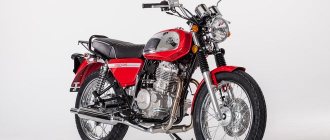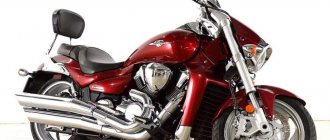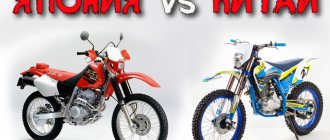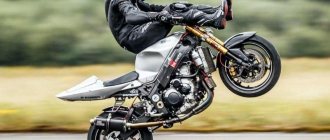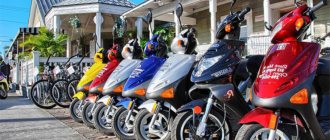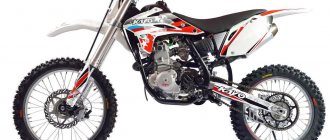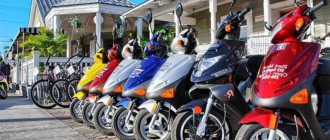Just a couple of decades ago, motorcycle lovers had to choose between “Java”, “Jupiter” and “Ural”, but now you can easily buy motorcycles from famous world manufacturers. For many years now, the Japanese company Honda has been considered the leader in the production of motorcycles, offering bikers a wide range of equipment for every taste and in various price ranges. One of the most popular bikes is the Honda vfr 800 fi, which belongs to the super sports class motorcycles, combining the parameters of a sprinter with maximum acceleration and a stayer with a stable average speed. This model of motorcycle vehicle can be used both in city conditions (it has high maneuverability) and on the highway, where it can be used to reach speeds of up to 240 km/h.
How the VFR 800 modification appeared on the motor market
For the first time, the Honda VFR 800 became available to motorsports enthusiasts in 1998 as a sports touring model, replacing the fairly popular motorcycles of the Honda VFR750 series. If we turn to the official regulatory and technical documentation, this modification is called the Honda vfr 800 fi Interceptor, and the FI marking stands for Fuel Injector - since the release of the first modification of this equipment, it has been equipped with an injection-type engine. Interceptor is a designation added to models sold in the United States.
The Honda vfr 800 fi has quite a lot of differences from its predecessor - a new design, an injection-type engine with increased displacement, and a new brake system with ABS installed. The 2002 model comes with VTEC, but does not feature the patented gear timing technology, replacing it with a traditional chain drive. The presence of a diagonal frame made of aluminum, a rear pendulum design of the console type, variable VTEC timing modes and wheel rotation control make it possible to give the bike additional maneuverability and power. In 2010, based on the engine and chassis of this model, the VFR800X Crossrunner modification was designed and released - a touring enduro that is in demand among outdoor enthusiasts.
Honda VFR800F – TEST
2014 onwards, 782 cm3, 106 l. s., 239 kg, 600,000 rub.
text: Alexander Barkalov photo: Honda
“Nearly 30 years ago, the sophisticated engineering of Honda’s design department laid the foundation for a new generation of truly unique motorcycles that not only combined the best qualities of the company’s sports and touring machines, but were also equipped with a somewhat revolutionary V4 engine. The last generation of the famous VFR800F was released at the beginning of the last decade - in 2002 - and since then a huge army of fans of the model have been eagerly awaiting the next generation of the motorcycle.
I will not hide: I was looking forward to the trip to test the new VFR800F, which took place on the outskirts of the Spanish city of Alicante, located on the shores of the Mediterranean Sea, with undisguised impatience. A few years ago I had the chance to spend a couple of days with the latest version of the Japanese sports tourer, during which the VFR managed to charm me. It is quite natural that from meeting the new product I expected to receive a lot of positive emotions and make several pleasant discoveries for myself. Despite the generally optimistic mood, there was still some preconceived opinion regarding the new VFR800F, and my main complaint about the motorcycle was its appearance. The first photos from the Milan EICMA exhibition, where the sixth generation VFR800F was officially presented, were frankly disappointing: a blunt “face” in the spirit of the older VFR1200, huge side fairing shields and an old-fashioned muffler, which, following tradition, was again moved to the rear wheel area. Frankly speaking, there is no trace left of the innovative design inherent in the previous generation model. Another reason to express dissatisfaction was the engine of the new product, the characteristics of which on paper were identical to those of the power unit of its predecessor. Looking ahead, I will say that after the test, both claims against the VFR800F were categorically withdrawn!
Generation 6 The VFR family of sport-touring motorcycles has always held a special place in Honda's lineup, taking V-fours from the racetrack to the public road. The VFR model, which appeared in the mid-80s and almost immediately became a bestseller, two years later was further developed in the form of two branches - the racing VFR750R and the road sports VFR750F. At that time, the motorcycle turned out to be truly universal, allowing you to move comfortably in dense city traffic day after day, go to the track on weekends, and go on long trips during vacations. The second generation VFR was introduced at the very beginning of the 90s of the last millennium. The updated motorcycle boasted not only a changed design and minor technical improvements, but also sported a cantilever rear wheel mount, which over time became the calling card of the model. Four years later, in 1994, Japanese engineers rolled out the third generation of the model, which continued to follow trends in the world of sports motorcycles of that period and, in addition, inherited a design in the style of the famous NR750. In 1998, the management of the Honda concern decided to update the legendary motorcycle. The engine displacement was increased to 781 cm3, and the carburetor was replaced by a PGM-FI fuel injection system. Traditionally, devices of the VFR family have been a kind of test platform on which the company's latest developments were tested in mass production. For example, on the VFR800F, for the first time in the history of Honda motorcycles, a complex combined braking system - DCBS - appeared. In general, the motorcycle has become more “tourist”, flexible, with a fairly even torque scale at all speeds. The chassis of the 800 “vyfer” has also undergone many changes compared to the 750. Among the most notable innovations are a new 41 mm cartridge fork, called HMAS, and a modified cantilever swingarm at the rear wheel.
The next, fifth generation VFR, debuted in 2002. The motorcycle received a completely new design, which included new plastic cladding, thoroughly redesigned front optics and two mufflers moved under the “tail” of the device. The main technical innovation was the appearance of the VTEC system, which, after passing the 6000 rpm mark, connected two additional valves per cylinder, which provided a noticeable “pickup” and made it possible for the engine not to “fade away” at the “tops.” The appearance of the VTEC system had virtually no effect on the maximum power indicator, but the engine characteristics in the low and medium speed range were significantly smoothed out, due to which the dip in the first half of the speed range completely disappeared. To implement VTEC, engineers had to abandon the gear timing mechanism in favor of a chain drive of the two overhead camshafts. In addition, this solution made it possible to reduce the weight of the power unit, mechanical losses and significantly reduce the noise level. The first look at the real Honda VFR800F 2014 model year was enough to understand that even the highest quality photographs cannot accurately convey the appearance of the device: “in real life” the motorcycle looks much more harmonious and is definitely not without attractiveness. While working on the appearance of the model, Japanese designers were guided by the new corporate style of Honda, which was first shown to the public on the example of the V4 Concept, and subsequently served as the basis for creating the appearance of the Honda VFR1200F model. Without exaggeration, the most striking design feature of the new Vyfer is the all-LED head optics. Adding to the elegance of the silhouette is the fact that the new VFR has managed to significantly lose weight: by moving the radiators from the sides to the front, the width of the motorcycle has decreased from 540 to 500 mm. In general, the image of the model is still inextricably associated with previous Honda sports-touring cars and bears the signature features of the VFR family, shrouded in an aura of speed and comfort. Since we are talking about losing excess weight, we cannot help but note the achievements of the Japanese in this field. Leaving the previous aluminum frame unchanged, Honda specialists replaced the steel subframe with an aluminum one, saving 2 kg. In addition, the abandonment of double mufflers under the tail fairing not only made it possible to lower the center of gravity of the device, improving mass distribution, but also reduced the total weight of the motorcycle by another 7 kg. In total, the new model turned out to be 10 kg lighter than its predecessor!
Updates The ergonomics of the workplace on the previous generation Honda VFR800F hardly deserved criticism, but the company's engineers still considered it possible to make changes designed to make the rider's stay behind the wheel even more comfortable. First of all, the position of the clip-ons was changed, which became 13 mm higher and 6.5 mm closer to the motorcycle pilot. The 2014 model has the ability to adjust the seat height from 789 mm to 809 mm, which will be acceptable for riders of almost any height. Despite the driving position of the new VFR with a significant forward tilt of the body, you feel really comfortable: the load on your back and arms becomes noticeable only after long trips at low speeds, where there is practically no “support” of the oncoming air flow. Speaking about the “decoration” of the pilot’s workplace, one cannot fail to mention the new instrument panel, which, in terms of the amount of data displayed, can compete with other automobile analogues. As befits a motorcycle with a sporty accent, the instrument panel is dominated by a dial tachometer, sandwiched between two LCD displays. Together, all devices inform the rider about the number of the selected gear, fuel consumption and reserve, temperature “overboard”, etc. The heated clip-on handles included in the standard equipment have a five-step adjustment of the heating intensity - and information about the selected operating mode is displayed directly on one of the LCD screens.
One of the nice innovations of Honda is the turn indicators, which turn off... on their own! The operating algorithm of the system is quite simple: after turning on the turn signal, the control unit, receiving data from the ABS sensors, begins to compare the rotation speeds of the front and rear wheels. At the moment when the speeds of both wheels are equalized, the system concludes that the maneuver is completed and turns off the turn signal. For cases where overtaking occurs smoothly and, therefore, the difference in wheel speed is minimal, two additional scenarios apply. In the first case, when the motorcycle speed is less than 50 km/h, the turn signal turns off independently after covering 120 m of the path. In the second scenario, when the motorcycle is traveling at a speed above 50 km/h, the turn signal turns off after seven seconds. In city traffic conditions and on country highways, the new system showed its best side, working correctly in all situations. To some, such a feature may seem like an absolute trifle, but personally, I am extremely surprised that this convenient option did not appear a few years earlier. Inspecting the driver's seat of the new VFR800F, the eye of an experienced motorcyclist will involuntarily be drawn to the small remote control on the left clip-on, located above the head optics control unit. Here, in a place that prevents accidental pressing, there is a button to turn off the traction control. The TCS system, which is standard on the new Honda, does not provide the rider with any adjustments, but works extremely delicately and covers a wide range of conditions and situations. Another “trick” that recently came to “civilian” motorcycles from the world of big-time motorsport, along with traction control, was the quickshifter. A device that allows you to upshift without releasing the gas or opening the clutch has also made its way to the new generation VFR800F. True, only as an option. Agile steam locomotive The fiery V-shaped engine of the Honda VFR800F retains all the proportions of the previous model, without exception. The power of the 4-cylinder 782 cc engine also remained unchanged, but, according to Honda experts, they managed to improve the nature of torque delivery in the low and medium speed zone. Japanese engineers managed to achieve this result thanks to a whole range of measures, including redesign and reconfiguration of exhaust channels, as well as refinement of the variable valve timing system. To be honest, I was not able to feel the improved torque delivery. The Japanese “four” still readily responds to the movement of the throttle, dynamically accelerating the VFR800F almost from idle and right up to the red zone of the tachometer. But what has really changed in the operation of the engine is the algorithm for operating the VTEC system.
If earlier, at the moment when two additional valves per cylinder were “put into play,” the motorcycle received noticeable acceleration, accompanied by the characteristic sound of the engine, now, having crossed the 6500 rpm mark, you almost don’t feel the long-awaited push, being content only with the signature sound accompaniment. Later, in a conversation with the project manager, it was possible to find out that the refusal to “pick up” was made deliberately, after interviewing many owners of the previous generation VFR800F. With regret I have to admit: the model’s engine has completely lost its hooligan fervor, which, however, does not prevent it, as before, from accelerating the 239-kilogram device surprisingly quickly and at the same time predictably. If only a few nostalgic people will mourn the lost “pickup”, then absolutely everyone will appreciate the handling of the Japanese “sport tourist”. Featuring a Pro-Arm cantilever swingarm and a new 43mm HMAS telescopic fork, the VFR kit is by no means new, but it performs to the envy of many more modern systems. Having driven several tens of kilometers along local serpentines, I was not at all surprised by the choice of the mountain roads of Spain as a testing ground for the new generation VFR. Here, on picturesque winding “paths” replete with closed turns, 180-degree hairpins and long turns, the chassis of the motorcycle worked without exaggeration perfectly. The motorcycle easily and quickly shifted from one turn to another, surprising us with its agility over and over again. The model stands on the trajectory with reinforced concrete confidence, while allowing further turning when changing the turning radius. Of course, one cannot call the suspension soft and pliable: as befits a proper “sport tourist”, the maneuverability of the motorcycle is placed above sybaritic joys. At times, “working out” large bumps in the road was a little harsh, but one cannot dare to blame the motorcycle for lack of comfort.
One of the strongest points of most Honda vehicles (and the VFR is no exception) has always been the braking system. The new product of the Japanese concern, like its predecessor, is equipped with a combined brake system - DCBS. The capabilities of two 310mm brake discs and 4-piston Tokico calipers are plenty, and for backup there is a 256mm rear disc and 2-piston caliper. When talking about a touring motorcycle, we cannot ignore the topic of fuel consumption. If you trust the passport data provided by the manufacturer, then the new Honda VFR800F can cover more than 400 km on one 21.5-liter tank. In terms of conventional units of fuel consumption, this means that a motorcycle consumes about 5.4 liters of gasoline per 100 km. The real “gluttony” of the device, naturally, differed from what was promised: the average fuel consumption during a 160-kilometer test trip was approximately 7.3 liters per 100 km. However, it is worth clarifying here: the group of journalists participating in the test moved at a very high pace, limiting the speed of movement only by common sense and road conditions. Therefore, we can safely say that during everyday “civilian” use, the average fuel consumption will be noticeably more modest. Before starting the test, I could not answer one question for myself: is the 2014 VFR800F a representative of the new generation of Honda sports touring motorcycles or a thoroughly modified model of the previous generation?
I guess I didn’t find the answer even after the test! On the one hand, the device has “lost weight”, received a completely new design, updated chassis and improved electronics. On the other hand, the V4 engine, which is the highlight of the family, has remained virtually unchanged and can no longer boast outstanding characteristics over its competitors. However, VFR has always been above the competition, and its buyers are, in a sense, special people. Incredible versatility, innovative design, racing roots and the famous 90-degree V-4 engine are just a few of the reasons why thousands of Vyffer owners around the world have stuck with their motorcycles, patiently waiting for the next generation to arrive. models. According to Honda analysts, there are about 75,000 owners of VFR series vehicles of various generations in Europe alone! And you can be sure that with the release of the new Honda VFR800F, the ranks of this “army” will only swell. /
Bike generations
Today you can find three main generations of this modification of the bike:
- 5th generation - produced from 1998 to 2001. This model used a high-power injection engine, plastic linings from the VTR100 and a combined brake system;
- 6th generation – 2002-2013 The modification is equipped with double exhaust pipes, ABS and a system that changes the timing and stroke of the valves;
- 8th generation – production started in 2014 and continues to this day. Honda vfr 800 Interceptor of this series has an original design, instrument panel, one exhaust, wheels of reduced weight and control of engine power characteristics. In the United States, “Standard” and “DeLuxe” versions are sold; in Europe and the Russian Federation, only “Standard” can be purchased.
Honda vfr 800 vtec is a fairly prestigious type of motorcycle belonging to the “above average” class. But at the same time, the bike is not involved in official motorcycle competitions, since it does not have a sufficient number of additional settings. Among the distinctive features of motorcycles in this series are the aerodynamic front part of the bike, the use of carbon fiber to create body kits, each of which serves as protection for a specific component or assembly. The technical characteristics of the Honda vfr 800 vtec model are such that the tail can be dismantled without any problems to access a specific unit.
Non-standard modifications
In addition to the basic configurations, successfully sold on the European and American markets, you can find the motorcycle in a version dedicated to the anniversary of the Honda company - Honda VFR 800i Anniversary. This version is similar to the basic modification, but is made in silver and red tones, but it is not in great demand.
Many motorcyclists in our country and around the world fell in love with the Honda vfr 800 fi motorcycle in the “sport-tourist” version, equipped with a more environmentally friendly engine. In this version of the motorcycle engine, the fuel injection parameters have been changed, a catalytic converter has been installed, allowing for maximum purification of gases and significantly reducing the level of harmful emissions. At the same time, the “sport tourist” is equipped with an automatic fuel mixture enricher, the presence of which simplifies starting the engine in the cold season. The clutch is also modified - in this version it is softer, and the motorcyclist starts off more smoothly.
Electrical equipment
The motorcycle is equipped with a 12-volt electrical circuit:
- ignition system – electronic in full;
- battery - 12 volts/10 ampere-hours;
- engine starting – electric starter;
- generator power – 497 watts;
- headlights - four 55-watt halogen lamps, low and high beam, in pairs;
- turn signals - four 15-watt lamps, two front ones in white corrugated shades, two rear ones under red plastic caps;
- brake light - red light with a 40-watt lamp.
The year 2004 was marked by the modernization of the motorcycle in terms of the installation of new electrical options. Buttons have appeared that turn on special beacons for emergency parking, and some other signaling devices.
Engine design features
In the Honda vfr 800, the technical parameters are such as to provide a combination of comfort, power and controllability of the motorcycle. The chassis of this modification with an 800 cc engine. cm. quite different from the 750 cc version. cm. Separately, we can highlight the front fork, which has undergone dramatic changes - the diameter of the “stays” has increased to 41 mm, which makes it possible to give the motorcycle additional stability while riding. After the update, the design became known as the Honda Multi Action System, and has been successfully used for many years. In the updated version, the rear suspension has changed and began to be designed in the form of a cantilever pendulum, which has a positive effect on driving characteristics. The presence of D-CBS (combined braking system) has significantly increased the safety of riding a motorcycle, especially at high speeds and emergency braking.
Electrical and ergonomics
In the Honda vfr 800 model, the technical parameters of the electrical system are improved due to the installation of a modern relay regulator. In order to reduce the likelihood of the bike being stolen, this series is equipped with a proprietary immobilizer - Ignition Security System. In the Honda VFR 800 version of the motorcycle, relative to the previous model, the side rear view mirrors are modified, equipped with aluminum alloy brackets, made in a fantastic style. The bike's mirrors are slightly offset towards the body, which allows them to be hidden from drops of precipitation.
Photo gallery
Thanks to its good build quality, the VFR 800 is still quite popular in its circles. The production of this bike continues to this day, we invite you to familiarize yourself with its changes from generation to generation. Enjoy watching.
Specifications
The technical characteristics of this modification are selected to ensure maximum comfort, safety and power of the bike while driving both in the city cycle and on the highway. The installed 4-cylinder DOHC engine is equipped with 16 gas distribution valves, thanks to which it is possible to obtain a torque of 80 Nm and a power of up to 107 horsepower. The use of a PGM-FI injector in the injection system allows you to obtain fuel consumption in the range of 6-6.5 liters per 100 km, which is considered an average for bikes of this class. According to reviews from owners, real consumption figures are slightly higher - 8-10 liters, but at the same time you can feel the maximum power of the motorcycle in free riding mode in the urban cycle.
In 2001, an updated version of the Honda vfr 800 vtec was introduced, which features an improved gas distribution system that allows optimizing engine afterburner with a sharp increase in power indicators.
This version features a specially designed muffler with integrated noise reduction system. It uses a straight-through exhaust cone design, equipped with 2 cones, which makes the engine sound like a small turbine. As the speed increases, the sound becomes louder, but does not exceed acceptable limits.
Design features of the chassis and braking system
If you read reviews about the Honda vfr 800 on the Internet on specialized forums and websites, you can hear many positive opinions regarding the running equipment. The front suspension is implemented using a cartridge telescopic fork with a stroke of 10.8 cm. The rear suspension is an adjustable cantilever pendulum, equipped with a gas-oil shock absorber with a stroke of 12 cm.
The technical characteristics of the brakes of the Honda VFR 800 bike are selected in such a way as to ensure their optimal performance while driving. On the front wheel there is a double disk with ventilation and a hydraulic system of a combined standard, on the rear - similar to the front one, but single.
Appearance
The VFR 800 initially seems quite wide; plastic body kits give it volume.
However, upon closer inspection, it is not that wide. But the existing body kits give a smooth shape, which is important for aerodynamics.
These body kits completely cover the front part, so of all the engine elements you can only see the radiator, and even then - in the front part, behind the wheel.
The V-shaped double headlight at the front gives the motorcycle a certain predatory appearance . A transparent fairing rises up from the headlights, behind which is a digital instrument panel.
Behind the steering clip-ons there is a “humpbacked” tank, providing the driver with a reclining position.
Due to the volume of the tank, the double seat is located almost entirely on the rear fender. Starting from the seat level, you can at least slightly examine the design; the frame and elements of the rear suspension appear.
On the right side there is a single exhaust pipe.
One of the most successful motorcycles from the global brand, Honda, is the XR 600 R, let’s look at its characteristics.
You can evaluate the range of Honda ATVs in our topic: https://themoto.net/atv/yaponskie-atv/honda-atv/obzor-modeley.html
Constant improvements to the bike
Just look at any review about this motorcycle, and it becomes clear that Honda specialists are constantly working to make the VFR 800 more advanced, while satisfying the needs of motorcycle enthusiasts. To this end, the technical parameters of the Honda vfr 800 bike are regularly improved - in the latest modifications, low and medium speeds have been equalized, dips that occurred with a sharp increase in power indicators have been eliminated, and the fuel injection system has been improved.
Despite the fact that many bike owners did not quite like the replacement of the gear mechanism with a chain drive, it became easier to repair, since the transmission was modernized at the same time. The modernization of the gearbox led to the fact that the first gear became shorter and the rest longer. Among the important changes in the latest versions is the increase in weight due to the installation of additional rear suspension brackets, but their installation made the frame more rigid and reliable. In the 2003 release, attention was drawn to ABS, which was especially in demand for the “sports-tourism” class.
With each new series, the VFR 800 modification is subject to restyling - in the latest series, the exterior of the bike is changed, on which matte chrome-plated mufflers are installed, the turning lights are shifted, the windshield is tinted, and plastic parts are made in black.
New restyling
In 2006, the VFR 800 was once again modernized. The manufacturer has radically redesigned the VTEC system to soften the parameters of its operation. There have been complaints from owners about turning on the option too abruptly, causing the motorcycle to jerk. The connection point for the backup pair of valves had to be shifted to lower speeds, from 6800 to 6600 rpm, and the position of the automatic shutdown switch had to be shifted from 6600 to 6100 rpm. In combination with the new injector settings, the connection of the four-valve mode has become smoother.
The latest modernization has brought noticeable changes to the exterior of the motorcycle. The chrome mufflers became matte, the turn signals were shifted to the center, the windshield was tinted, all plastic parts changed their black color to the main color of the motorcycle.
Bike price
The cost of the Honda VFR 800 model is one of the questions of interest to many motorcycle enthusiasts. On the Internet (on bulletin boards and specialized websites) you can find the cost of a new bike ranging from 3,000 to 7,000 USD. depending on the year of manufacture and configuration. A new one costs a little more – 9-14 thousand.e. It is worth separately noting the fact that the model is quite popular, so you can find spare parts, components and assemblies for such motorcycles not only from official dealers, but also in numerous motorcycle stores and even at engine dismantling yards.
Owner reviews
On thematic forums you can find many posts regarding this bike model, most of them positive. Owners of the Honda Crossrunner vfr800x and other modifications of this motorcycle are especially pleased with the chassis of the motorcycle, shock-absorbing properties and strength characteristics of components and assemblies. Quite often you can come across the concept “vfr800 is a men’s motorcycle model,” and this is due to the somewhat aggressive appearance and technical characteristics of the equipment. Many motorcycle owners are pleased with the braking system, which is distinguished by its reliability and the presence of ABS, which prevents the bike from skidding while driving (this is especially important when riding on a wet road). The power of the Honda vfr800 version of the motorcycle does not leave anyone indifferent either – it is optimally selected for such a mass of the bike and its performance characteristics.
Specifications
| Maximum engine power: | 107 HP |
| Torque: | 80 Nm |
| Working volume: | 782 cm3 |
| Motor type (cylinder arrangement, number of strokes): | DOHC, four-cylinder, water-cooled, 16-valve timing |
| Number of cylinders: | 4 |
| Number of valves: | |
| Intake type (Injector / Carburetor): | |
| Bore and stroke: | |
| Starting system (Electric starter, kick starter): | |
| Maximum speed in km/h: | 242 km/h |
| Cooling system: | water cooling |
| Transmission (gearbox): | six-speed manual |
| Clutch (Dry / Wet): | |
| Drive unit: | Chain |
| Frame: | aluminum, diagonal |
| Chassis | |
| Suspension (front/rear travel): | |
| Brakes (Front/Rear): | |
| Wheels / Tires / Rubber: | |
| Dimensions and weight | |
| Dimensions (Length / Width): | |
| Seat height: | |
| Ground clearance: | |
| Curb weight: | |
| Wheelbase: | 1460 mm |
| Weight: | 218 kg |
| Fuel tank capacity: | 22 l. |
| Battery capacity: | |
| Year of release: | |
| Country of Origin: |

